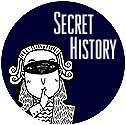
Comment
on this story |
 |

What used to be at 19 Market Square? Well....
by Jack Neely
Most of the 40-odd buildings that make up the two sides of Market Square are genuinely historic. But a few of the buildings on the square are snubbed in the National Historic Register as "non-contributing" structures. They're too new, and too plain, to be considered historic. But what if a non-historic building has a historic basement? Does that count for anything?
That's the case with the space at number 19 Market Square. The historic register document estimates its construction at 1960, a willfully unhistoric time when few buildings were built to be looked at. It's a plain brick two-story building, blank windowless walls on the second floor. Some gravestone-shaped wooden panels were hung up there to force a resemblance to the building's neighbors: the faux shutters are weathered gray and some have fallen off.
On the ground floor is what most of us think of as one of the main entrances to the late Watson's Department Store. David Dewhirst owns it, and has allowed its open area to be used for a variety of public purposes, including the Market Square charrette last June. Until recently it was also used by Theatre Central, the troupe of manic thespians that have been mounting high-speed comedies around downtown for years. They're now on North Gay, across from Regas.
The floors are linoleum. There's no hidden stamped-tin ceilings here, no mysterious archways like you find in some other Market Square buildings. Nothing on the ground floor looks older than the era of fluorescent lighting. However, there's a door in there that leads down underneath the ground floor, to another era.
The basement's barely big enough to stand up in, and you have to duck under the pipes and floor joists. One of Theatre Central's stalwart actors, Ed White, has been doing some spelunking down there, and has found a few things you might not find in your own basement. Several mismatched shoes a little past the point where they might profit from a shine. Some steak bones, liquor and muscatel bottles. A few old church-key style beer cans: Budweiser and Stag. Some bottles of forgotten beverages. Desiccated rats in assorted sizes, admirably holding their shape.
A thick layer of entertainment memorabilia. Several trade magazines, like Box Office and Motion Picture Herald, dating from 1938 through 1945. Photos of Bing Crosby and Betty Grable and Dick Powell. Disposable bingo cards, lots of them, unused. Cartons of popcorn salt. A layer of ancient junk-food containers. Milk Duds, Baby Ruth, Good and Plenty, Black Crow, Peanut Krispies, Goldenberg's Peanut Chews, Fancy Cuts. They're mostly boxes folded flat as if they've never been packed: hundreds, maybe thousands of them, forming a soft carpet over the rubble.
Even the rubble itself gets your attention. It's the ruins of a demolished Victorian building. Lots of bricks and splintered wood, with several chunks of ornately carved marble. Apparently hand-sculpted, a couple of pieces show a design like a curvaceous cornstalk. You get the impression that at some time in the past, someone knocked a building down and didn't bother to clear the debris before they built another on top.
The layers—the rubble, the movie stuff, the shoes—form geological eras. McClung Collection provides some clues about how to interpret them. Like most of Market Square, Number 19 has a history reaching back well over a century. It was, in turn, a harnessmaker, a stove shop, a furniture store. Around 1905, it was one of Frank DeArmond's saloons. For 30 years after that, it was a butcher shop; maybe that accounts for the steak bones. Then, briefly, it was Ira Watson's store. Its second and third floors served as a boarding house.
Then, for six years encompassing World War II, 19 Market Square was the Rialto Theatre. Some movie theaters, like the Tennessee, were much larger than any today, but some were small enough to fit in a storefront. Ed found a book of the Rialto's check stubs among the rubble.
It closed in the '40s, like a lot of downtown's smaller theaters. They moved out around 1945 without taking all their stuff. For some years after that, 19 Market Square was the Hopson Brothers Dept. Store. Maybe the shoes are its only remnant. But on the upper floors that had been a boarding house, was a hallway of interesting businesses that could have been the set for one of the film-noir movies shown downstairs. The Quiet Hour Book Shop. Gertrude's Beauty Shop. The Hole in the Wall Cigar Store. And, in the days when all gumshoes wore fedoras, the Collins Detective Agency.
The upper floors were vacant after the mid-'50s, except for a second-floor "sport center," usually a euphemism for a gambling joint. By 1962, this building and the one next to it were combined together to become Eagle's 5 Cents and $1 Store. Maybe that's when the old three-story building vanished, yielding to the new two-story one here today. Meanwhile, Watson's had been growing to three, then four storefronts down the square. They acquired this building in the late '70s.
White got salvage dibs on the stuff he's found in the basement. Some of the bottles are collectors' items. He hasn't yet found anything of enormous monetary value, but he hauled out some of the more interesting chunks of marble and iron. They'll serve as decadent sculpture for his Ft. Sanders garden and may survive to perplex future historians.

December 4, 2002 * Vol. 12, No. 49
© 2002 Metro Pulse
|





